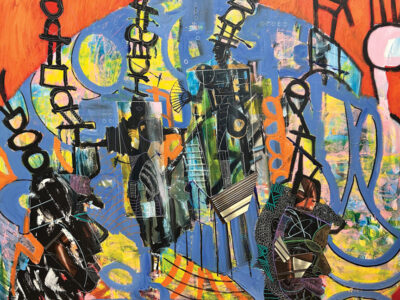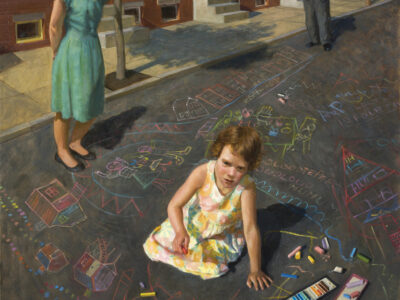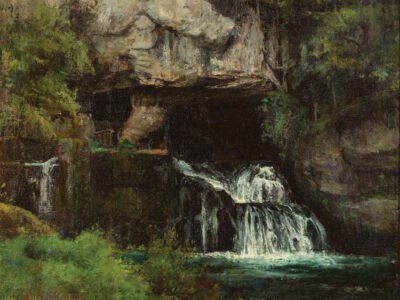PIETER BRUEGEL
By Larry Silver, faculty
Abbeville Press, 2011. $150.
Larry Silver has loved the painted world of Pieter Bruegel since his first grand tour of Europe as a college sophomore 45 years ago. In Vienna’s Kunsthistorisches Museum he was confronted by the “overwhelming experience” of the large “Bruegel room,” which was filled with works by the Flemish master—including, Silver recalls, “most of the best pictures.” When he got back to the University of Chicago he promptly took a course called “Bosch to Bruegel”—affectionately known as “Borscht to Bagel,” he says—and has never looked back.
Since then Silver has written such well-regarded books as Hieronymus Bosch, Art in History, Rembrandt’s Faith, and Peasant Scenes and Landscapes. Now the James and Nan Farquhar Professor of Art History at Penn, he has just published the spectacular Pieter Bruegel (Abbeville Press), which is filled with gorgeous reproductions of Bruegel’s entire oeuvre in various media, as well as abundant scholarly commentary.
“It is surely the most beautiful book I will ever be associated with,” says Silver of his lifelong labor of love, “and I hope that it wins this wonderful artist some new admirers as ardent as I am.”
Senior editor Samuel Hughes, whose admiration was sufficiently ardent that he refused to let the book leave his office, asked Silver to comment on a few of his favorite works.
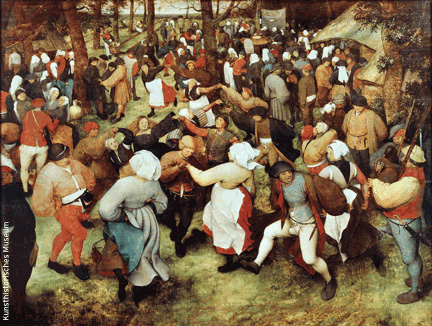
“Peasant Wedding Dance” (above)
“Bruegel quickly came to be known as ‘Peasant Bruegel’ for subjects like this one, which shows a much lower and closer viewpoint than his ‘Carnival and Lent’ celebrations (see p. 66). The occasion is a once-a-year saint’s festival, or kermis, which had a basis in village church celebration, notably marked by the banner hung outside a tavern; however, as that venue suggests, like St. Patrick’s Day in America, a kermis also quickly led to more rowdy entertainments of dance, drink, and the comical couples who smooch and pair off across the setting. Here the artist’s mastery of his full-bodied villagers with their cartoon-like faces brings a smile to our faces, in a smugness of social superiority admixed with common humanity.”
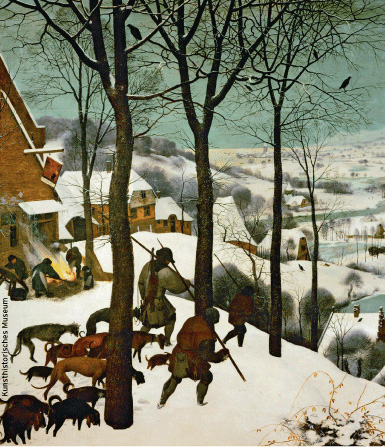
“Hunters in the Snow” (detail)
“One of the artist’s most brilliantly composed landscapes shows us his formulaic diagonal recession from a foreground corner perch into the distant mountains at the far horizon. This wonderful evocation of slate skies against deep winter snow once formed part of a suite of panels dedicated to ‘The Months’ (probably originally six, of which five survive, including the ‘Grain Harvesters’ at the Metropolitan Museum). This scene shows labors of the season, including the roasting and smoking of a pig for later consumption and a last, meager hunting expedition on the estate of an implied nobleman (the series was commissioned by a tax collector in suburban Antwerp). But the distant Flemish village shows familiar winter recreation on the ice, a favorite Bruegel subject in separate paintings and prints and a legacy he bestowed to the history of art.”
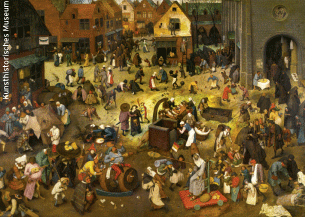
“The Combat between Carnival and Lent”
“Bruegel here shows us an imaginary main city square, flanked on one side by taverns and on the other by a local church. His fascination with folklore is very much in evidence, beginning with the two eponymous allegorical personifications in the foreground but also a pilgrim couple and a fool in motley at the center. Their conflict is mutually self-defining, as the gluttony and self-indulgence of Mardi Gras is suddenly opposed by Ash Wednesday and the askesis of Lent (note their contrasting foods, cholesterol-rich at left and fish at right). Bruegel also shows us lepers and beggars in the urban setting, amidst festive dancers but also dark-robed almsgivers. His omniscient overview suggests social superiority and distance above these comically simplified faces and bodies.”
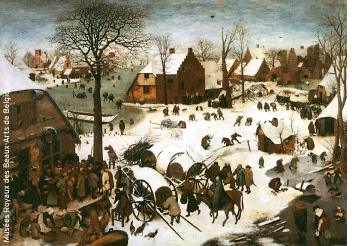
“Census at Bethlehem”
“At first glance, this image repeats a beloved Bruegel formula: the local Flemish village viewed in the midst of winter, now animated with activities across frozen ponds and outside a crossroads tavern. Once more a slate-gray sky and bare branches before a low-lying sun mark the short days. But amidst all of this activity, one can note that, under a seasonal wreath, many townspeople are registering before an official at the tavern, which has hung out the double-headed eagle of the (Holy) Roman Empire. And in the right center foreground a skinny carpenter with his tools is leading both an ox and an ass, on which his cloaked wife is seated as they head for the tavern to seek a place at the inn.
“In an ‘aha moment,’ Bruegel suddenly shows us the Christian holy figures on their way to the stable with its manger and the Christmas moment, which will unfold in (at this point, at least) anonymity, as if it were happening in reenactment in the artist’s own homeland and present day. Of course, there is a religious message in that transposition—a message of true humility and kinship between the sacred and the everyday rather than a presentation with obvious spiritual glory of angels and haloes—thus a far cry from the standard church altarpieces of the Nativity.”

“Painter and his Client”
“Bruegel was very much a commercial artist, who made designs for print publishers in the busy commercial port of Antwerp and whose paintings, while surely sometimes commissioned, also included panels sold at the developing municipal open market. In this drawing, which was rapidly copied by followers, the painter mocks the commercial nexus linking the creative artist to a buyer. Both figures are parodied: the artist, with a scruffy anticipation of a bohemian working craftsman, warily assessing his work; the purchaser, already reaching for his coin-purse, as a short-sighted, gaping philistine.”


